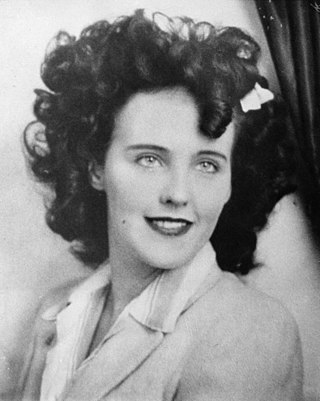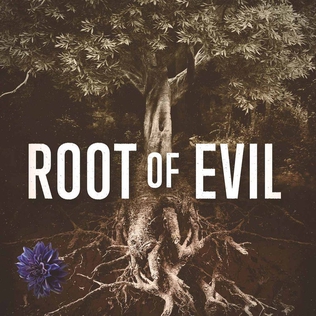
Lee Earle "James" Ellroy is an American crime fiction writer and essayist. Ellroy has become known for a telegrammatic prose style in his most recent work, wherein he frequently omits connecting words and uses only short, staccato sentences, and in particular for the novels The Black Dahlia (1987), The Big Nowhere (1988), L.A. Confidential (1990), White Jazz (1992), American Tabloid (1995), The Cold Six Thousand (2001), and Blood's a Rover (2009).

The Black Dahlia (1987) is a crime fiction novel by American author James Ellroy. Its subject is the 1947 murder of Elizabeth Short in Los Angeles, California, which received wide attention because her corpse was horrifically mutilated and discarded in an empty residential lot. The investigation ultimately led to a broad police corruption scandal. While rooted in the facts of the Short murder and featuring many real-life people, places and events, Ellroy's novel blends facts and fiction, most notably in providing a solution to the crime when in reality it has never been solved. James Ellroy dedicated The Black Dahlia, "To Geneva Hilliker Ellroy 1915-1958 Mother: Twenty-nine Years Later, This Valediction in Blood." The epigraph for The Black Dahlia is "Now I fold you down, my drunkard, my navigator, My first lost keeper, to love and look at later. -Anne Sexton."

The Cleveland Torso Murderer, also known as the Mad Butcher of Kingsbury Run, was an unidentified serial killer who was active in Cleveland, Ohio, United States, in the 1930s. The killings were characterized by the dismemberment of twelve known victims and the disposal of their remains in the impoverished neighborhood of Kingsbury Run. Most victims came from an area east of Kingsbury Run called "The Roaring Third" or "Hobo Jungle", known for its bars, gambling dens, brothels, and vagrants. Despite an investigation of the murders, which at one time was led by famed lawman Eliot Ness, then Cleveland's Public Safety Director, the murderer was never apprehended.

Elizabeth Short, known posthumously as the Black Dahlia, was an American woman found murdered in the Leimert Park neighborhood of Los Angeles on January 15, 1947. Her case became highly publicized owing to the gruesome nature of the crime, which included the mutilation of her corpse, which was bisected at the waist.

My Dark Places: An L.A. Crime Memoir is a 1996 book, part investigative journalism and part memoir, by American crime-fiction writer James Ellroy. Ellroy's mother Geneva was murdered in 1958, when he was 10 years old, and the killer was never identified. The book is Ellroy's account of his attempt to solve the mystery by hiring a retired Los Angeles County homicide detective to investigate the crime. Ellroy also explores how being directly affected by a crime shaped his life - often for the worse - and led him to write crime novels. The book is dedicated to his mother.

John "Jonathan" Gilmore was an American author and gonzo journalist known for iconoclastic Hollywood memoirs, true crime literature and hard-boiled fiction.
The Wonderland murders, also known as the Four on the Floor Murders or the Laurel Canyon Murders, are four unsolved murders that occurred in Los Angeles, California, United States, on July 1, 1981. It is assumed that five people were targeted to be killed in the known drug house of the Wonderland Gang, three of whom—Ron Launius, William "Billy" Deverell, and Joy Miller—were present. Launius, Deverell, and Miller, along with the girlfriend of an accomplice, Barbara Richardson, died from extensive blunt-force trauma injuries. Only Launius' wife Susan survived the attack, allegedly masterminded by organized crime figure and nightclub owner Eddie Nash. Nash, his henchman Gregory Diles, and porn star John Holmes were at various times arrested, tried, and acquitted for their involvement in the murders.

Georgette Elise Bauerdorf was an American socialite and oil heiress who was strangled in her home in West Hollywood, California. Her murder remains unsolved.
Many Black Dahlia suspects, or persons of interest, have been proposed as the unidentified killer of Elizabeth Short, nicknamed the "Black Dahlia", who was murdered in 1947. Many conspiracy theories have been advanced, but none have been found to be completely persuasive by experts, and some are not taken seriously at all.

The murder of Cheri Jo Bates occurred in Riverside, California, on October 30, 1966. Bates, an 18-year-old college freshman, was stabbed and slashed to death on the grounds of Riverside City College. Police determined the assailant had disabled the ignition coil wire and distributor of Bates' Volkswagen Beetle as a method to lure her from her car as she studied in the college library. The murder itself remains one of Riverside's most infamous cold cases, and has been described by some locals as a murder which "stripped Riverside of its innocence".

The World's Greatest Unsolved Crimes is a book written by Roger Boar and Nigel Blundell which was first published in 1984 by Octopus Books as part of their World's Greatest series. It contains accounts of various unsolved mysteries such as murders, unexplained disappearances and scandals.
Ann Toth (1922–1991) was a Hollywood starlet and girlfriend of Mark Hansen, who operated the Florentine Gardens in Hollywood. She befriended and roomed at the Carlos Avenue, Hollywood residence with Elizabeth Short, prior to Short's sensational murder on January 15, 1947.

The Cecil Hotel is an affordable housing complex in Downtown Los Angeles. It opened on December 20, 1924 as a budget hotel. In 2011, the hotel was renamed the Stay On Main. The 14-floor hotel has 700 guest rooms. The hotel has a checkered history, with many suicides and deaths occurring there. Renovations started in 2017 were halted by the COVID-19 pandemic, resulting in the hotel's temporary closure. On December 13, 2021, the Cecil Hotel was reinaugurated as an affordable housing complex.

George Hill Hodel Jr. was an American physician and suspect in the murder of Elizabeth Short, a.k.a. the Black Dahlia. He was never formally charged with the crime. He was also accused of raping his daughter, Tamar Hodel, but was acquitted for that crime. He lived overseas several times, primarily between 1950 and 1990 in the Philippines.

Michelle Eileen McNamara was an American true crime author. She was the author of the true crime book I'll Be Gone in the Dark: One Woman's Obsessive Search for the Golden State Killer, and helped coin the moniker "Golden State Killer" of the serial killer who was identified after her death as Joseph James DeAngelo. The book was released posthumously in February 2018 and later adapted into the 2020 HBO documentary series I'll Be Gone in the Dark.
The Black Dahlia: A Crime Graphic Novel is a graphic novel adaptation of James Ellroy's novel The Black Dahlia, by Alexis Nolent and David Fincher, and illustrated by Miles Hyman. Originally published in 2013 in French as Le Dahlia Noir, it was published in English in June 2016, by Archaia Entertainment, a division of Boom! Studios.

Fauna Hodel was an American author and motivational speaker, who wrote the true-crime memoir One Day She'll Darken: The Mysterious Beginnings of Fauna Hodel, documenting her unusual beginnings and the connection to her grandfather, George Hodel, a prime suspect in the infamous Black Dahlia murder mystery.

The Root of Evil: The True Story of the Hodel Family and the Black Dahlia or simply, Root of Evil, is an American investigative crime podcast covering the Black Dahlia murder and suspect George Hodel. The podcast was produced as a partnership between Cadence13 and TNT as a companion to the fictional television series I Am the Night. The podcast is hosted by Yvette Gentile and Rasha Pecoraro, George Hodel's great-granddaughters. It features interviews with those who were impacted by the murder, including Hodel's relatives. The podcast charted in the United States, United Kingdom, Australia, and Canada, reaching the number one spot in the United States on April 21, 2019.
Who Is the Black Dahlia? is a 1975 television film about the true crime unsolved murder of 22-year-old Elizabeth Short. Leonard Maltin's Movie Guide gives the film an Above Average rating, and states "… this atmospheric crime drama is intriguingly written and well cast down to the cameos."














